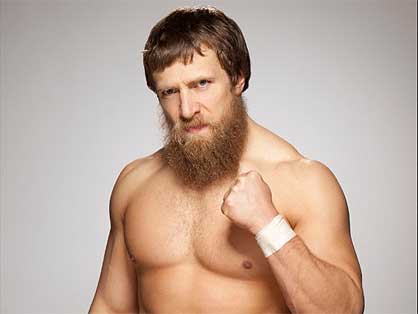
Daniel Bryan is not what most people would envision when picturing a professional wrestler.
He’s not a huge man; he’s not even a particularly large man. In the bowels of Verizon Center a few hours before a recent taping of WWE’sMonday Night Raw he stands at equal – or even lesser – height as the various non-grapplers who are milling about.
He wears a flannel shirt with baggy jeans, and his full, shaggy beard is the only aspect of his appearance that would make casual bystanders give him a second glance. (And wouldn’t earn even that at, say, a Bon Iver concert.)
In conversation, his sentences aren’t peppered with exclamations or catchphrases, and he has deep thoughts about this form of entertainment that many might not expect are possible.
“One of the things that people don’t understand – even people here, people within the company – to me, wrestling is art,” says the 31-year-old native of Aberdeen, Washington.
“It’s a form of performance art. And there’s so much that goes into it that other people aren’t seeing.”
But maybe you should envision someone like Bryan when you picture a professional wrestler.
As he and the WWE superstars gear up for today’s Wrestlemania 29, the regular-looking, regular-sounding Bryan is representative of a new generation of superstars who don’t share much in common with the over-muscular and overexaggerated wrestling personalities of the recent past.
Wrestlemania, professional wrestling’s biggest annual event, by a factor of many, will be held this year at New Jersey’s MetLife Stadium before 80,000 diehard fans.
Casual fans – 1.2 million pay-per-view orders were placed last year – will be at home forking over their $60 to see whether Hollywood crossover star and returning, conquering hero the Rock can defend his WWE championship against the current face of the company, John Cena, or whether the Undertaker can defeat upstart C.M. Punk to win his 21st consecutive Wrestlemania match.
Bryan wrestled at Wrestlemania last year and knows this is a great chance to make his mark and earn new fans.
“That’s the time when you can really show off,” he says of wrestling’s Super Bowl. “And you have to mentally prepare for it, too. You got to be on your game.”
Bryan’s path to WWE was built on giving his best showing night after night on stages microscopic compared to the scale of that on which he’ll perform on Monday.
Ad Feedback
Over a decade, he has worked for dozens of companies on the sprawling independent wrestling circuit, from Pennsylvania to Japan, and earned a reputation as one of the best technical wrestlers in the world.
This means he is someone who can make any move in the ring look devastating, graceful and believable, whether he is on the giving or receiving end – an essential skill for a wrestler.
Bryan eventually made it to the WWE – which turned Hulk Hogan, “Stone Cold” Steve Austin and the Rock into household names – without the one key ingredient to those stars’ success: a gimmick.
So there’s a certain irony that Bryan is more popular than ever thanks in large part to the simplest catchphrase imaginable: “No!” The back story of how his character has won over fans by shouting this single word involves a relationship gone wrong, a vengeful ex forcing Bryan into a feud with a fearsome masked giant (Kane), the two rivals enrolling in anger management classes and eventually becoming tag-team champions. Bryan is somewhat baffled by how this story line has evolved, but he takes it in stride.
“I don’t consider it wrestling,” says Bryan, who will compete alongside Kane in a tag-team championship match on Monday.
“I’ve done wrestling. Everywhere. And just by being a good wrestler you can become popular. But not here. It’s more important to be entertaining than it is to be a great wrestler. It’s fascinating to me. Some things just stick. Why it happens, I have no idea.”
Bryan’s match at last year’s Wrestlemania lasted all of 18 seconds. He lost to Sheamus, a hulking, pale Irish brute who finishes his opponents with the Brogue Kick – which is a catchy way of saying “big boot to the face.”
“I felt my knees get weak,” Sheamus, 35, says of his first Wrestlemania moment, which came back in 2010 when he was in a high-profile match against one of WWE’s biggest stars, Triple H. After last year’s unfortunate cameo, he hopes to get much more time in the squared circle this year.
“When you get to ‘Mania, the football [stadium] with over 80,000 seats and you’re walking down the ramp before the doors open and you look at the stands . . . I hope [my match] lasts a lot longer so I can absorb the atmosphere.”
While Sheamus looks more like a traditional wrestler, he’s also representative of the new generation and WWE’s emphasis on authenticity – which is admittedly tricky when dealing with scripted material that often makes headlines for its absurdity.
“If you go back to the ’80s, I didn’t really know much about the characters,” Sheamus says. “I knew what they did in the ring. I knew Hogan went off and spouted lots of crazy promos, and Ultimate Warrior did the same. They really were just characters. Now the superstars are more like people, more human. And I think that’s a good thing.”
-Washington Post